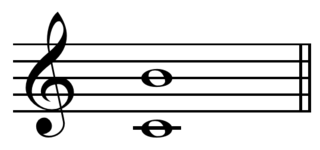In music, an octave or perfect octave is a series of eight notes occupying the interval between two notes, one having twice the frequency of vibration of the other. The octave relationship is a natural phenomenon that has been referred to as the "basic miracle of music", the use of which is "common in most musical systems". The interval between the first and second harmonics of the harmonic series is an octave. In Western music notation, notes separated by an octave have the same name and are of the same pitch class.

In music, harmony is the concept of combining different sounds together in order to create new, distinct musical ideas. Theories of harmony seek to describe or explain the effects created by distinct pitches or tones coinciding with one another; harmonic objects such as chords, textures and tonalities are identified, defined, and categorized in the development of these theories. Harmony is broadly understood to involve both a "vertical" dimension (frequency-space) and a "horizontal" dimension (time-space), and often overlaps with related musical concepts such as melody, timbre, and form.
In music theory, a scale is any set of musical notes ordered by fundamental frequency or pitch. A scale ordered by increasing pitch is an ascending scale, and a scale ordered by decreasing pitch is a descending scale.
In music theory, an interval is a difference in pitch between two sounds. An interval may be described as horizontal, linear, or melodic if it refers to successively sounding tones, such as two adjacent pitches in a melody, and vertical or harmonic if it pertains to simultaneously sounding tones, such as in a chord.
In music theory, the tritone is defined as a musical interval spanning three adjacent whole tones. For instance, the interval from F up to the B above it is a tritone as it can be decomposed into the three adjacent whole tones F–G, G–A, and A–B.
In music, solfège or solfeggio, also called sol-fa, solfa, solfeo, among many names, is a music education method used to teach aural skills, pitch and sight-reading of Western music. Solfège is a form of solmization, though the two terms are sometimes used interchangeably.
The term blues scale refers to several different scales with differing numbers of pitches and related characteristics. A blues scale is often formed by the addition of an out-of-key "blue note" to an existing scale, notably the flat fifth addition to the minor pentatonic scale. However, the heptatonic blues scale can be considered a major scale with altered intervals.
Relative pitch is the ability of a person to identify or re-create a given musical note by comparing it to a reference note and identifying the interval between those two notes. For example, if the notes Do and Fa are played on a piano, a person with relative pitch would be able to identify the second note from the first note given that they know that the first note is Do without looking.
A seventh chord is a chord consisting of a triad plus a note forming an interval of a seventh above the chord's root. When not otherwise specified, a "seventh chord" usually means a dominant seventh chord: a major triad together with a minor seventh. However, a variety of sevenths may be added to a variety of triads, resulting in many different types of seventh chords.

In music theory, limits or harmonic limits are a way of characterizing the harmony found in a piece or genre of music, or the harmonies that can be made using a particular scale. The term limit was introduced by Harry Partch, who used it to give an upper bound on the complexity of harmony; hence the name.
In music, ear training is the study and practice in which musicians learn various aural skills to detect and identify pitches, intervals, melody, chords, rhythms, solfeges, and other basic elements of music, solely by hearing. Someone who can identify pitch accurately without context is said to have "perfect pitch", while someone who can't perceive these qualities is said to be "tone deaf". The application of this skill is somewhat analogous to taking dictation in written/spoken language. As a process, ear training is in essence the inverse of reading music, which is the ability to decipher a musical piece by reading musical notation. Ear training is typically a component of formal musical training and is a fundamental, essential skill required in music schools and the mastery of music.

In classical music, a third is a musical interval encompassing three staff positions, and the major third is a third spanning four half steps or two whole steps. Along with the minor third, the major third is one of two commonly occurring thirds. It is qualified as major because it is the larger interval of the two: the major third spans four semitones; the minor third, three. For example, the interval from C to E is a major third, as the note E lies four semitones above C, and there are three staff positions from C to E. Diminished and augmented thirds span the same number of staff positions, but consist of a different number of semitones.
The intervals from the tonic (keynote) in an upward direction to the second, to the third, to the sixth, and to the seventh scale degrees of a major scale are called major.

In music theory, a minor third is a musical interval that encompasses three half steps, or semitones. Staff notation represents the minor third as encompassing three staff positions. The minor third is one of two commonly occurring thirds. It is called minor because it is the smaller of the two: the major third spans an additional semitone. For example, the interval from A to C is a minor third, as the note C lies three semitones above A. Coincidentally, there are three staff positions from A to C. Diminished and augmented thirds span the same number of staff positions, but consist of a different number of semitones. The minor third is a skip melodically.

In music from Western culture, a seventh is a musical interval encompassing seven staff positions, and the major seventh is one of two commonly occurring sevenths. It is qualified as major because it is the larger of the two. The major seventh spans eleven semitones, its smaller counterpart being the minor seventh, spanning ten semitones. For example, the interval from C to B is a major seventh, as the note B lies eleven semitones above C, and there are seven staff positions from C to B. Diminished and augmented sevenths span the same number of staff positions, but consist of a different number of semitones.
The intervals from the tonic (keynote) in an upward direction to the second, to the third, to the sixth, and to the seventh scale degrees (of a major scale are called major.

In the music theory of harmony, the root is a specific note that names and typifies a given chord. Chords are often spoken about in terms of their root, their quality, and their extensions. When a chord is named without reference to quality, it is assumed to be major—for example, a "C chord" refers to a C major triad, containing the notes C, E, and G. In a given harmonic context, the root of a chord need not be in the bass position, as chords may be inverted while retaining the same name, and therefore the same root.
In music theory, the scale degree is the position of a particular note on a scale relative to the tonic—the first and main note of the scale from which each octave is assumed to begin. Degrees are useful for indicating the size of intervals and chords and whether an interval is major or minor.
In Western music, the adjectives major and minor may describe an interval, chord, scale, or key. A composition, movement, section, or phrase may also be referred to by its key, including whether that key is major or minor.
An arpeggio is a type of broken chord in which the notes that compose a chord are individually sounded in a progressive rising or descending order. Arpeggios on keyboard instruments may be called rolled chords.

In music theory, the harmonic major scale is a musical scale found in some music from the common practice era and now used occasionally, most often in jazz. In George Russell's Lydian Chromatic Concept it is the fifth mode (V) of the Lydian Diminished scale. It corresponds to the Raga Sarasangi in Indian Carnatic music, or Raag Nat Bhairav in Hindustani music.
EarMaster is a music application for Windows, Mac, iOS and Android launched in 1996 by Danish editor Miditec, who changed its name to EarMaster ApS in 2005. The first prototype version of the software was DOS-based, but since 1996, it has been ported to multiple operating system. The main focus of EarMaster is ear training and sight-singing, even though EarMaster seems to tend towards a more general approach to music teaching since v. 4.0, covering a broader spectrum of music theory and practice.







